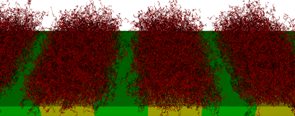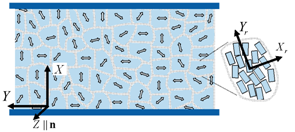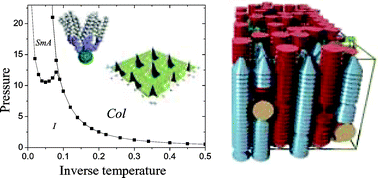| A. Koutsioubas and A. G. Vanakaras, Langmuir, 24 (23), 13717–13722 (2008). DOI: 10.1021/la802536v |
|
Abstract: Structural properties of polymer brushes tethered on a periodically nanopatterned substrate are investigated by computer simulations. The substrate consists of an alternating succession of two different types of equal-width parallel  stripes, and the polymers are end-tethered selectively on every second stripe. Three distinct morphologies of the nanopatterned brush have been identified, and their range of stability has been determined in terms of a single universal parameter that combines the grafting density, the polymer length, and the stripe width. We propose scaling relations for the average brush height and for the architectural properties of the outer surface of the nanopatterned brush under good solvent conditions. Our analysis provides guidelines for fabricating well-defined and tunable nanopatterned polymeric films. Copyright © 2008 American Chemical Society
stripes, and the polymers are end-tethered selectively on every second stripe. Three distinct morphologies of the nanopatterned brush have been identified, and their range of stability has been determined in terms of a single universal parameter that combines the grafting density, the polymer length, and the stripe width. We propose scaling relations for the average brush height and for the architectural properties of the outer surface of the nanopatterned brush under good solvent conditions. Our analysis provides guidelines for fabricating well-defined and tunable nanopatterned polymeric films. Copyright © 2008 American Chemical Society
A.G. Vanakaras and D.J. Photinos, J. Chem. Phys., 128, 154512 (2008).
 Abstract: An intermediate nematic phase is proposed for the interpretation of recent experimental results on phase biaxiality in bent-core nematic liquid crystals. The phase is macroscopically uniaxial but has microscopic biaxial, and possibly polar, domains. Under the action of an electric field, the phase acquires macroscopic biaxial ordering resulting from the collective alignment of the domains. A phenomenological theory is developed for the molecular order in this phase and for its transitions to purely uniaxial and to spontaneously biaxial nematic phases.
Abstract: An intermediate nematic phase is proposed for the interpretation of recent experimental results on phase biaxiality in bent-core nematic liquid crystals. The phase is macroscopically uniaxial but has microscopic biaxial, and possibly polar, domains. Under the action of an electric field, the phase acquires macroscopic biaxial ordering resulting from the collective alignment of the domains. A phenomenological theory is developed for the molecular order in this phase and for its transitions to purely uniaxial and to spontaneously biaxial nematic phases.
Related Works:
- Theory and simulation of biaxial nematic and orthogonal smectic phases formed by mixtures of board-like molecules, A. G. Vanakaras, M. A. Bates and D. J. Photinos, Phys. Chem. Chem. Phys. 5(17), 3700 (2003).
- The phase behavior of a binary mixture of rodlike and disclike mesogens: Monte Carlo simulation, theory, and experiment, A. Galindo, A. J. Haslam, S. Varga, G. Jackson, A. G. Vanakaras, D. J. Photinos and D. A. Dunmur, J. Chem. Phys. 119(10), 5216 (2003).
- On the Molecular requirements for the stabilization of thermotropic Biaxial ordering in Rod-Plate nematics, A. G. Vanakaras, A. F. Terzis and D.J. Photinos, Molec.Cryst. Liq. Cryst., 362, 67-78 (2001).
- Theory of biaxial nematic ordering in rod-disc mixtures revisited, A. G. Vanakaras and D.J. Photinos, Molec.Cryst. Liq. Cryst., 299, 65-71 (1997).
- Hydrogen bonding and phase biaxiality in nematic rod-plate mixtures, A. G. Vanakaras, S. C. McGrother, G. Jackson and D. J. Photinos, Molec.Cryst. Liq. Cryst., 323, 199 (1998).
http://www.matersci.upatras.gr/SoftMat/Research/PDF/JCP08_BiaxClusters.pdf
S.D. Peroukidis, A.G. Vanakaras and D.J. Photinos, J. Phys. Chem. B , 112(40), 12761-12767 (2008).
 Abstract: The molecular cubic-block model [J. Chem. Phys. 2005, 123, 164904] is used to study a class of poly(benzyl ether) fullerodendrimers that have recently been reported to form columnar liquid crystal phases. In agreement with experiment, the model-molecules are found to self-assemble into columns which form hexagonal or rectangular lattices. The columnar cross sections are elongated in the rectangular phase. Transitions to the isotropic phase, either directly or through the intermediate formation of smectic phases, have been found. The effects of dissolving small amounts of nonbonded fullerene molecules have been explored. The results predict that the fullerene solutes restrict the range of stability of the columnar phase and may induce transitions from the columnar to the smectic or the isotropic phase. ©2008 American Chemical Society
Abstract: The molecular cubic-block model [J. Chem. Phys. 2005, 123, 164904] is used to study a class of poly(benzyl ether) fullerodendrimers that have recently been reported to form columnar liquid crystal phases. In agreement with experiment, the model-molecules are found to self-assemble into columns which form hexagonal or rectangular lattices. The columnar cross sections are elongated in the rectangular phase. Transitions to the isotropic phase, either directly or through the intermediate formation of smectic phases, have been found. The effects of dissolving small amounts of nonbonded fullerene molecules have been explored. The results predict that the fullerene solutes restrict the range of stability of the columnar phase and may induce transitions from the columnar to the smectic or the isotropic phase. ©2008 American Chemical Society
Related Works:
, S. D. Peroukidis, A. G. Vanakaras and D. J. Photinos,
J. Chem. Phys.,
123, 164904 (2005).
, S. D. Peroukidis , A. G. Vanakaras and D. J. Photinos,
Soft Matter,
4, 493-499 (2008).
A. G. Vanakaras and D. J. Photinos,
J. Mater. Chem. 15, 2002-2012 (2005).
S.D. Peroukidis, A.G. Vanakaras and D. J. Photinos, Soft Matter, 4, 493-499 (2008).
 Abstract: A molecular model of cubic building blocks is used to describe the mesomorphism of conical fullerenomesogens. Calculations based on density functional molecular theory and on Monte Carlo computer simulations give qualitatively similar results that are also in good agreement with the experimentally observed mesomorphic behaviour. The columnar and lamellar mesophases obtained are non-polar, and their relative stability is controlled by a single model parameter representing the softness of the repulsive interactions among the building blocks of the conical molecules.
Abstract: A molecular model of cubic building blocks is used to describe the mesomorphism of conical fullerenomesogens. Calculations based on density functional molecular theory and on Monte Carlo computer simulations give qualitatively similar results that are also in good agreement with the experimentally observed mesomorphic behaviour. The columnar and lamellar mesophases obtained are non-polar, and their relative stability is controlled by a single model parameter representing the softness of the repulsive interactions among the building blocks of the conical molecules.
 stripes, and the polymers are end-tethered selectively on every second stripe. Three distinct morphologies of the nanopatterned brush have been identified, and their range of stability has been determined in terms of a single universal parameter that combines the grafting density, the polymer length, and the stripe width. We propose scaling relations for the average brush height and for the architectural properties of the outer surface of the nanopatterned brush under good solvent conditions. Our analysis provides guidelines for fabricating well-defined and tunable nanopatterned polymeric films. Copyright © 2008 American Chemical Society
stripes, and the polymers are end-tethered selectively on every second stripe. Three distinct morphologies of the nanopatterned brush have been identified, and their range of stability has been determined in terms of a single universal parameter that combines the grafting density, the polymer length, and the stripe width. We propose scaling relations for the average brush height and for the architectural properties of the outer surface of the nanopatterned brush under good solvent conditions. Our analysis provides guidelines for fabricating well-defined and tunable nanopatterned polymeric films. Copyright © 2008 American Chemical Society
